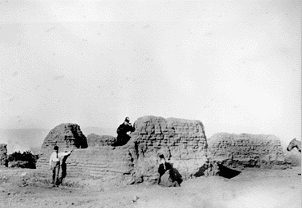

Since 1769 California had been under Spanish rule. That meant that European rulers could decide the fate of all the people who had lived there in freedom. The lives of the Native Americans were to change quickly.
According to some historical records, Father Francisco Dumetz travelled from the San Gabriel Mission to this valley in 1810. He is supposed to have been sent to find a good place for a ranch to help the San Gabriel Mission.
May 20 was the day dedicated to Saint Bernardino of Siena (San Bernardino in Spanish). Father Dumetz held a Mass (Roman Catholic church service) near a Cahuilla Indian village. He decided to name the valley after Saint Bernardine. That's how this County and the City got the name "San Bernardino." The place is marked with a historical landmark plaque. You can find it on the north side of Mission Road, between Mt. View Avenue and California Street.
Why Build A Mission Station?Why would the San Gabriel Mission want a ranch or station in the San Bernardino Valley?
|
San Bernardino County Museum |
The First "Estancia"It took nine years to establish the mission station. A little chapel was built, and a long storage building that could be a home or fortress for missionaries. |
The first estancia, pictured above, was just a storage shed, with room to sleep inside. |
The first order of business was to get plenty of water all year around. The priests wanted to grow grapes for wine they used in their church servies. They travelled several miles away and found a good creek that ran all the time. A foreman named Pedro Alvarez taught Indian workers how to dig out a ditch as the water softened the ground. The ditch, called a "zanja" in Spanish, carried water from Mill Creek in Mentone all the way to Mt. View Avenue in Loma Linda. Of course, neither the creek name nor the street existed then.
With a good water supply, fruit trees, grape vines, corn and other grains were planted. After eleven years, in 1830, the director of the "estancia" decided to move the operation to the top of a nearby hill. History books don't tell us why the mission was moved, but the first site lies very low in the area that has been regularly flooded by the San Timoteo Creek. Maybe the missionaries were tired of watching their hard work being washed away.
The Adobe "Mission"Spanish foremen taught Indians how to mix red clay dirt with water to make a gooey, thick mud. The mud was packed into wooden forms and dried in the sun. These mud bricks, called "adobe" were used to build strong buildings. The walls were up to two feet thick, and kept out heat and cold very well. Roofs were made of thatched reeds from the riverbanks and long trunks of trees. The second estancia had rooms where priests could stay, a small chapel, and storage rooms. |
After the mission station was abandoned, the roof beams were taken for building other buildings. The walls began to melt. People in the 1910's came to see the ruins. San Bernardino County Museum |